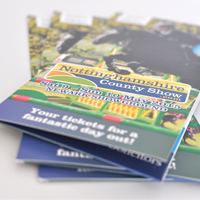
How Folds Can Make all the Difference to your Leaflets
Leaflets may be commonplace in the world of advertising, but that doesn’t mean yours have to look like the rest. You can try and apply some finishing or printing them on thicker stock, but there’s a much simpler option that can really make them stand out: how you choose to fold them.
We’re here to walk you through not only your fold options but how to benefit from that extra space, both creatively and as a business. Of course, if you’re seeking more information or seeking tailor-made advice based on your needs then simply email or call Visual Print & Design – you may even get a good deal on your next order.
Let’s start at the most basic fold: a half-fold turns two printed pages – sides of paper that can be printed on – into four. This can be used for a magazine-style layout, with an eye-catching covered followed by an interior full of images or information. This approach has the widest scale for design and creativity, with the potential to be combined with die-cutting to create a layered effect. If you’re looking to do something more interesting and artistic, then let’s explore leaflets with two folds.
There’s a surprising amount of complexity to these DL-sized flyers, with six sides to take advantage of. These are great for segmenting text and images, if you have a number of topics you’d like to cover. Typically you’ll see a lot of accordion folds, with pages unfolding from behind the other in a Z shape, but some go for a letter-folded leaflet, where overlapping pages open like a door from a central page. With each page being presented in a set sequence you can lead your audience and then wow them with a spread when its fully opened. If you’re willing to change the dimensions from the DL norm, then you could look into a gate-folded leaflet – a leaflet where each side is folded over half of the square backing. This style is perfect for more image-based leaflets, potentially having a picture that spans the front two side that opens up into a grand one in the centre.
Many of these above folds are versatile enough to be used with eight printed page flyers, extending them out by an extra fold. This is great if you have that extra bit of content you need to squeeze in, but why not try a roll fold? As the name suggest, each side folds out to from one side, making it a compact way to hand your audience all the content they need. A leaflet can even turn into a poster with the right style of folding – a sheet of paper folded in quarters will make for leaflet that can grow massively in size, making it a great promotional item. If you’re looking to increase the size even more then it’s just a matter of taking any of the mentioned styles, doubling the size of the paper and folding it in on itself. You can get some absolutely huge leaflets this way, going all the way up to 16 printed pages!
There’s so much that goes into the design of a humble leaflet, so it’s always important to ask how that design furthers your message, from the palette choice down to how it’s folded. Each of these options offer you a unique way to deliver your message to a client, with the ability to be taken advantage of artistically – just because it’s a leaflet doesn’t mean you can’t be creative with it! Don’t let your leaflets be lost in the sea of boring printed products, so next time you’re designing flyers think about how they fold and how to make those folds work for you.